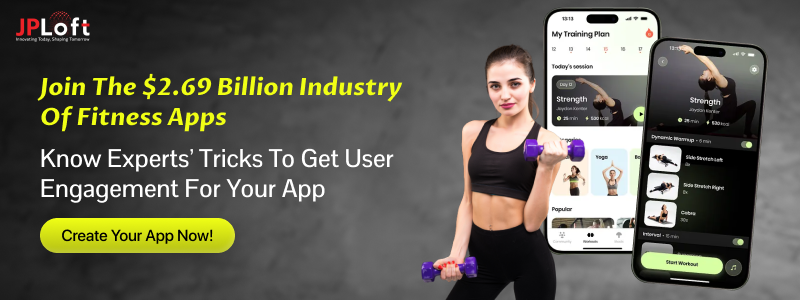Key Takeaways
The global fitness app market is growing rapidly, valued at USD 7.21 billion in 2023 and expected to reach USD 20.87 billion by 2030.
Development challenges include delivering accurate data, integrating wearables, personalizing routines, and creating a user-friendly interface.
Maintain user engagement by gamifying strategies like leaderboards, rewards, challenges, and social sharing, and personalized content.
Designing for scalability, multi-platform support, and offline functionality is crucial to handle growing users and maintain a seamless experience.
Beat the competitive market by focusing on niche segments, offering unique features, partnering with certified fitness experts, and making regular improvements.
Collaborating with JPLoft means gaining access to a skilled team specialized in custom fitness app development that stands out in the market.
At first, creating a fitness app may seem straightforward in today’s health-conscious digital world, but it comes with its own unique set of challenges. To stand out in this highly competitive market, you must navigate various challenges of creating such an app.
Now you might think: What are the challenges of building a fitness app?
The major challenge remains to balance rich engagement features and user simplicity. Other common challenges while creating a fitness app are delivering accurate health data, integrating wearable technologies seamlessly, diet & workout plan personalizations, and ensuring a user-friendly interface that motivates consistent engagement.
In this blog, we will be exploring the core challenges faced when creating a fitness app and how addressing them can set the foundation for long-term success.
Fitness App Concept and Its Related Market Stats
A fitness app is a digital platform designed to help users track, manage, and improve their health and wellness goals. It offers personalized workout routines, nutrition guidance, and progress tracking to create a holistic approach toward fitness.
With the growing awareness of healthy lifestyles, fitness apps have become an essential tool for individuals who want to exercise at their convenience, whether at home, the gym, or on the go. These apps cater to various fitness levels, from advanced athletes, providing guided video workouts, goal-setting options, and reminders to keep users motivated.
Many apps also integrate with wearable devices and smartwatches to monitor heart rate, calories burned, and activity levels in real time. By combining technology, personalization, and convenience, fitness apps empower users to take charge of their health journey. Whether aiming for weight loss, muscle gain, or simply staying active, a fitness app serves as a reliable companion.
Key features of a fitness app include:
-
Personalized workout and diet plans
-
Activity and progress tracking
-
Integration with wearables and smart devices
-
Video tutorials and guided sessions
-
Goal setting and reminders
-
Community challenges and social sharing
-
Nutrition and calorie tracking
► Current Market Stats of Fitness Apps
Here are the latest market statistics for fitness apps in 2025:
-
According to NMSC, the global fitness app market size was valued at USD 7.21 billion in 2023, predicted to reach USD 20.87 billion by 2030 with a CAGR of 16.4% from 2024 to 2030.
-
In research by SensorTower, fitness app downloads hit 3.6 billion across iOS and Google Play in 2024, up by 6%, with January 2025 in-app purchase revenue reaching USD 385 million.
-
As estimated by Fitbudd, the fitness app industry is expected to surpass USD 10 billion in 2025. Paid fitness apps contribute ~40% of the total revenue, and subscription-based apps show 30% higher user engagement.
-
According to Fitbudd, more than 74% of Americans use at least one fitness app, whereas 60% of users have already replaced gym memberships with app-based workouts.
-
It has been estimated by GrandViewResearch that North America leads the market, holding a 46.6% revenue share in 2024, and smartphones remain the largest platform for app usage.
These market statistics reflect the recent trends, user engagement patterns, segmentation, regional growth, and revenue of top fitness apps in the industry for 2025.
Before exploring the key challenges in developing a fitness app, we will check out the reasons behind this boom in the industry and why entrepreneurs and businesses are increasingly channeling resources into this segment.
Why Invest in a Fitness App?
Although there might be some challenges in making a fitness app, investing in it can still be a smart move for entrepreneurs and businesses due to the ongoing trends in health, technology, and consumer behavior. Here are the key reasons to invest in a fitness app:
1] Rising Demand for Health and Wellness
The global shift toward healthier lifestyles has increased the popularity of digital fitness solutions, with the estimated value of USD 4 billion growing at a CAGR of 30%. People tend to use apps that make workouts and diet tracking easy, making it a profitable opportunity for businesses entering this market.
2] Recurring Revenue Opportunities
Fitness apps can adopt multiple monetization models like subscriptions, in-app purchases, and premium memberships. Users are willing to pay for advanced features such as personalized plans or virtual coaching. This creates a steady stream of recurring income, making the business model sustainable.
3] Wide Target Audience
Fitness apps appeal to a broad demographic, from beginners to professional athletes. They also cater to different needs, such as weight loss, muscle gain, or overall wellness. This versatility ensures that your app can attract and retain a large user base.
4] Integration with the Wearables and IoT
Fitness apps can connect with smartwatches, fitness bands, and IoT-enabled devices. This integration enhances user experience by providing real-time tracking and analytics. It also increases the app’s value, making it more appealing and competitive in the market.
5] Brand Loyalty and Community Building
A fitness app allows businesses to create a strong community of engaged users. Features like leaderboards, challenges, and social sharing foster long-term user loyalty. A loyal community not only boosts retention but also strengthens brand reputation.
While investing in such an app offers great potential, it's important to understand the pitfalls involved and how to overcome challenges in developing a fitness app that truly meets user needs and stands out in a competitive market. With careful planning, innovation, and expert guidance, businesses can easily resolve these issues during the development process.
Understanding these challenges in making a fitness app will help you lay a strong foundation for building a successful and sustainable fitness app.
What are the Challenges While Creating a Fitness App?
Creating a fitness app is not as simple as developing an idea and launching it. It requires careful planning, technical expertise, and user-focused design. Below are the top development challenges in building a fitness app:
1. Lack of Market Research
Before starting an online fitness business, businesses must understand what users actually want in a fitness app. Not conducting thorough research on this market's needs, customer requirements, and latest trends can result in app failure. This lack of research may lead to creating an app that doesn’t solve real problems or stand out in the market.
Solution: Conduct surveys, analyze competitors, and study fitness trends to identify user pain points. Build features that address real-world problems rather than copying existing apps.
2. Choosing the Right Monetization Model
Many apps fail because they cannot sustain revenue in the long term. Deciding between free, freemium, or subscription-based models is tricky. The challenges while creating a fitness app lie in balancing user expectations with profitability without making the app feel overpriced.
Solution: Start with a freemium model to attract users and introduce premium features gradually. Test different revenue streams like subscriptions, ads, or partnerships to find what works best.
3. Creating Personalized User Experiences
Users prefer customized workout and diet plans based on their fitness goals. However, building personalization engines requires advanced algorithms and data analytics. The challenge is ensuring that recommendations feel truly tailored and effective.
Solution: Use AI/ML algorithms to analyze user data and provide tailored workout and diet plans. Allow manual customization so users feel in control of their journey.
4. Integration with Wearables and Smart Devices
Fitness enthusiasts often use wearables like Google Fit or Apple Watch. One of the major challenges while making a fitness app is ensuring seamless integration with these devices is technically difficult. This creates issues like choosing the right APIs, compatibility issues, APIs, and real-time data syncing.
Solution: Implement APIs from major wearable brands and test extensively across devices. Focus on the most popular integrations first and hire experienced on-demand app development services providers to integrate them seamlessly.
5. Ensuring Data Accuracy
An app that provides inaccurate data can frustrate users and harm credibility. From calorie counting to step tracking, accuracy is crucial for getting true health reports. Not using an accurate algorithm can lead to inconsistent sensor readings, varying user input, and potential inaccuracies in workout or health data.
Solution: Use reliable algorithms and validate results through beta testing. Regularly update the system to improve accuracy as more data is collected. Perform intensive mobile app testing across devices.
6. Maintaining Data Privacy and Security
Fitness apps collect sensitive health data such as heart rate, weight, and activity levels. Ensuring compliance with regulations like GDPR and HIPAA is critical. Failure to secure this data can lead to breaches, loss of trust, and legal issues while building a fitness app.
Solution: Encrypt sensitive data, follow regulations like GDPR/HIPAA, and use secure cloud storage. Clearly communicate privacy policies to build user trust and retain strong mobile app security.
7. Keeping Users Engaged
Many users download a fitness app but abandon it after a few weeks. The fitness app development challenges consist of designing engaging features for the users. Without integration of proper motivation-driven tools and features, user retention rates can drop significantly, causing the app to lose revenue streams.
Solution: Add gamification such as leaderboards, rewards, and daily challenges. Push timely notifications and reminders to motivate users without overwhelming them.
8. Handling Scalability Issues
As the user base grows, the app must handle higher loads of data and traffic. Poor scalability can cause performance lags, crashes, and poor user experience, making it one of the major disadvantages in creating a fitness app.
Solution: Build on scalable cloud platforms like AWS or Google Cloud. Use load balancing and modular architecture to handle growth smoothly. You can connect with the experts who must build a robust backend that supports growth without problems.
9. Standing Out in a Competitive Market
The fitness app market is already crowded with apps developed like MyFitnessPal and Nike Training Club. Being one of the major challenges while creating a fitness app is differentiating your app enough to attract and retain users.
Solution: Breaking into this competition requires innovation and unique features. Focus on a niche (like yoga, seniors, women’s fitness) and add unique features. Strong branding and influencer marketing can also boost visibility.
10. Designing a User-Friendly Interface
A fitness app should be easy to navigate, even for non-tech-savvy users. A complex UI/UX mobile app design can discourage users from exploring the app. Balancing simplicity with functionality is one of the constant challenges while building a fitness app.
Solution: Keep the UI simple with minimal steps for navigation. Run usability tests with real users to refine the design before launch.
11. Managing Development Costs
High-quality fitness apps require investment in technology, design, and testing. Budget limitations may force compromises in features or security. Managing the cost to build a fitness app while delivering a competitive product is a significant hurdle.
Solution: Start with an MVP (minimum viable product) focusing on core features. Outsource or hire dedicated developers to reduce expenses.
12. Providing Offline Functionality
Not all users have access to reliable internet during workouts. Adding offline features like downloadable workout videos or offline tracking is one of the common fitness app development challenges. Yet, it significantly enhances user satisfaction and retention.
Solution: Create a fitness app that allows users to download workout videos and store essential data offline. Sync progress automatically when internet access is restored.
13. Updating Content Regularly
Static workout plans or repetitive content can bore users. To keep users motivated, apps must offer fresh workouts, challenges, and nutrition advice. This requires consistent updates, which can be highly time-consuming.
Solution: Collaborate with trainers and nutritionists to add fresh content. Build an AI app to generate dynamic workout variations to keep users engaged.
14. Offering Multi-Platform Support
Users expect fitness apps to work across Android, iOS, tablets, and sometimes web platforms. Developing and maintaining cross-platform compatibility is complex, which becomes one of the biggest challenges while developing a fitness app. It demands extra testing, coding, and design consistency.
Solution: Use cross-platform frameworks like Flutter or React Native to reduce development time. Ensure consistent design across all devices. Hire an experienced mobile app maintenance services.
15. Building Trust and Credibility
Fitness is directly linked to health and well-being, so trust is critical. Without proven expertise, users may question the effectiveness of recommendations. Lack of credibility causes concerns about accuracy, reliability, and delivering results, all of which influence user confidence and retention.
Solution: Partner with certified fitness experts and highlight credentials. Add user testimonials, success stories, and transparent information to boost trust. Create an app and partner it with certified trainers, nutritionists, or medical professionals to boost credibility.
Developing a fitness app is filled with opportunities, but it also comes with significant challenges. Businesses that successfully overcome these key challenges in developing a fitness app can build a strong, reliable, and engaging platform that retains users in the long run.
With the right strategies and practices, technical execution, and focus on user needs, a fitness app can become a game-changer in the digital health and wellness industry. Let’s now look into the best practices to adopt to overcome challenges in building a fitness app.
Practices to Improve the Fitness App
To keep users motivated, engaged, and loyal, developers and businesses must continuously enhance the app. Here are some proven practices to adopt to overcome challenges in building a fitness app:
► Focus on User-Centered Design
Prioritize intuitive navigation, clear visuals, and minimal steps for completing tasks. A clutter-free interface with easy access to workouts, progress, and diet tracking helps retain users. Regular usability testing is key to identifying pain points and improving the app’s design.
► Offer Personalization
Users are more likely to stay engaged if the app feels tailored to their needs. Introduce AI-driven personalization to create custom workout routines, nutrition plans, and fitness goals. Allow flexibility for manual adjustments so users feel in control. Add personalized push notifications based on user activity.
► Ensure Data Accuracy and Reliability
Fitness apps deal with health-related data like calories, steps, and heart rate. Accuracy is critical for building trust. Integrate with reliable wearables and sensors, and continuously test algorithms to improve results. Clear progress reports and easy-to-read charts add value by helping users understand progress.
► Prioritize Data Privacy and Security
Since fitness apps collect sensitive personal and health information, strong security is essential. Use encryption, secure APIs, and compliance with GDPR or HIPAA regulations. Provide transparency through clear privacy policies, giving users confidence that their data is safe. Security also builds brand credibility.
► Add Gamification and Engagement Features
Motivation often drops after the initial excitement of downloading an app. To tackle this, include gamification elements like leaderboards, achievement badges, and daily streaks. Social sharing and community challenges help users to stay consistent. Partner with the best mobile app development company in the UK to add the best trendy features for your fitness app
► Regularly Update Content
Static workout plans and repetitive routines can bore users. Keep your content fresh by adding new exercise videos, expert advice, and fitness challenges. Partnering with trainers, nutritionists, or influencers can bring authentic and engaging updates that keep users coming back.
► Provide Multi-Platform Accessibility
Today’s users want flexibility, whether on iOS, Android, tablets, or the web. Building a cross-platform app ensures that users can seamlessly access their fitness data anytime. Consistent design and functionality across devices enhances the overall experience.
► Support Offline Functionality
Not all users have internet access during workouts, especially while traveling or in gyms with weak signals. Offering offline workout videos and tracking ensures that users can continue their routines without interruptions. Offline-first features make the app more reliable.
► Collect Feedback and Improve Continuously
User feedback is the backbone of app improvement. Provide in-app surveys, rating options, and responsive customer support. Regularly analyzing feedback helps identify new feature opportunities and fix issues quickly. Continuous improvement keeps apps relevant and competitive.
Improving a fitness app requires a blend of advanced mobile app tech stack, user-focused design, and consistent engagement strategies. By following these best practices, you can easily overcome fitness app development challenges, enhancing user satisfaction, improving retention rates, and standing out in a competitive market.
Talk to JPLoft's Experts and Build Your App
Are you ready to turn your fitness app idea into a powerful, user-friendly platform that motivates and engages users?
At JPLoft, we specialize in creating custom fitness apps tailored to your vision and market needs. Whether you aim to provide personalized workouts, nutrition guidance, or community-driven challenges, our team of expert developers, designers, and strategists will bring your concept to life.
From seamless wearable integration and accurate progress tracking to secure data management and gamification features, we cover every aspect to ensure your app stands out in this competitive market.
Partnering with JPLoft, a fitness app development company, gives you a team that values innovation, performance, and user engagement. We guide you through every step, from idea validation and prototyping to development, testing, and launch.
Talk to JPLoft’s experts today and build a fitness app that empowers users, drives results, and establishes your brand as a trusted name in the health and wellness industry. Your journey to creating a top-tier fitness app starts here.
Conclusion
The success of a fitness app goes far beyond attractive design or trendy features. Knowing what are the challenges of building a fitness app and using it to deliver a seamless, engaging, and reliable user experience is the goal. By focusing on personalization, accurate tracking, and intuitive navigation, businesses can ensure that users feel supported and motivated throughout their fitness journey.
Security and privacy are equally essential, as safeguarding sensitive health data builds trust and credibility. Incorporating gamification, community engagement, and regular content updates keeps users motivated and encourages long-term retention.
Multi-platform accessibility and offline functionality further enhance convenience, making the app a consistent companion for users on the go, and resolving the common challenges while creating a fitness app. Continuous feedback and iterative improvements ensure that the app evolves with changing user needs and market trends.
A well-executed fitness app not only helps users achieve their wellness goals but also establishes a strong, trustworthy brand presence in the competitive digital health space. Ultimately, helping the fitness app business grow and thrive seamlessly.
FAQs
Key challenges include user engagement, data accuracy, personalization, integration with wearables, privacy concerns, scalability, and staying competitive in a crowded market. Addressing these ensures a reliable, engaging, and user-friendly app.
Incorporate gamification, daily challenges, progress tracking, and community features. Personalized notifications and fresh content keep users motivated, helping to prevent app abandonment and encouraging long-term fitness habits.
Fitness apps collect sensitive health information like weight, heart rate, and activity levels. Protecting this data through encryption and regulatory compliance builds user trust and prevents potential legal or reputational issues.
Focus on unique features, niche audiences, and innovative experiences. High-quality content, gamification, and reliable performance help differentiate the app from competitors while attracting and retaining loyal users.
Use APIs from popular devices like Apple Watch and Google Fit. Test extensively for compatibility, real-time syncing, and accurate data transfer to provide a seamless user experience.













Share this blog